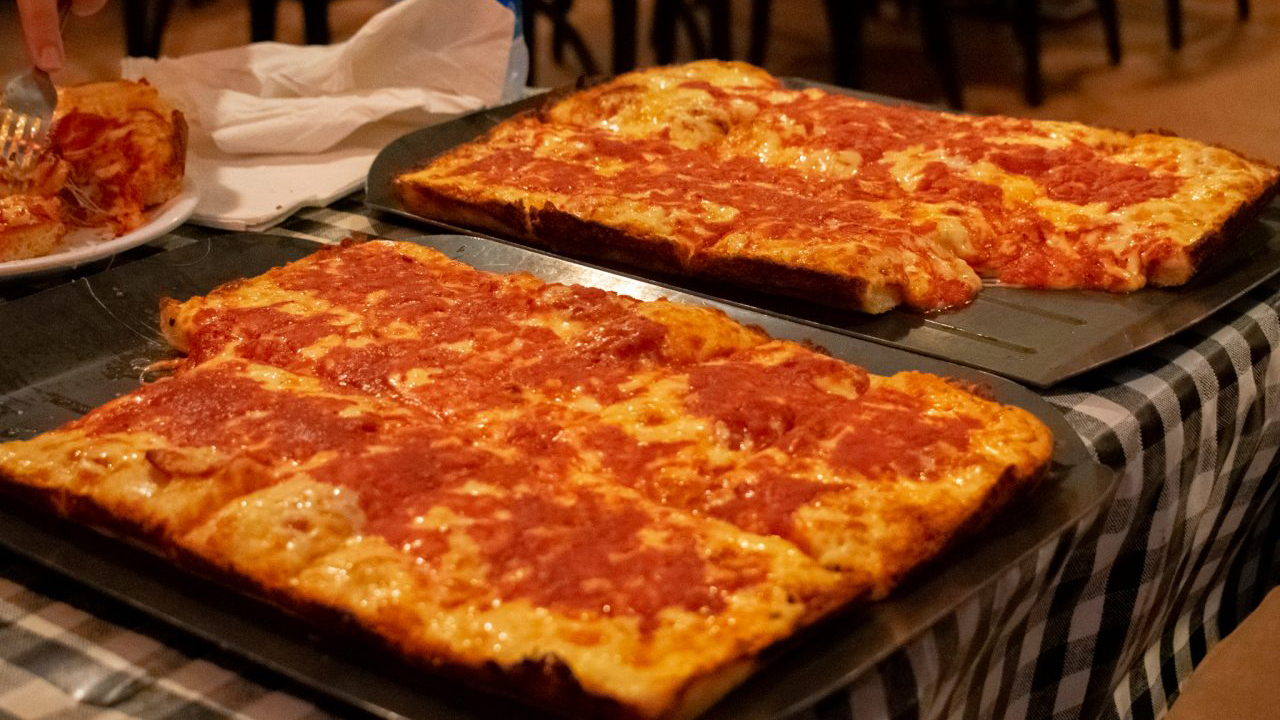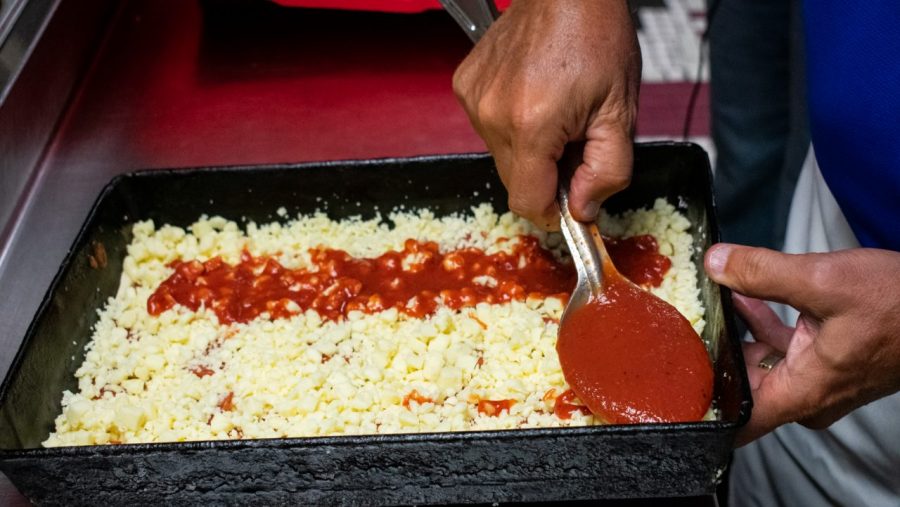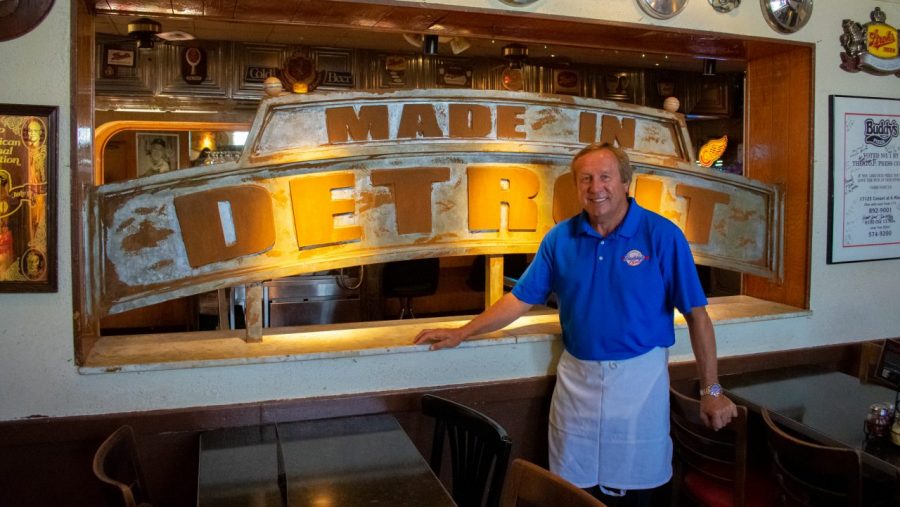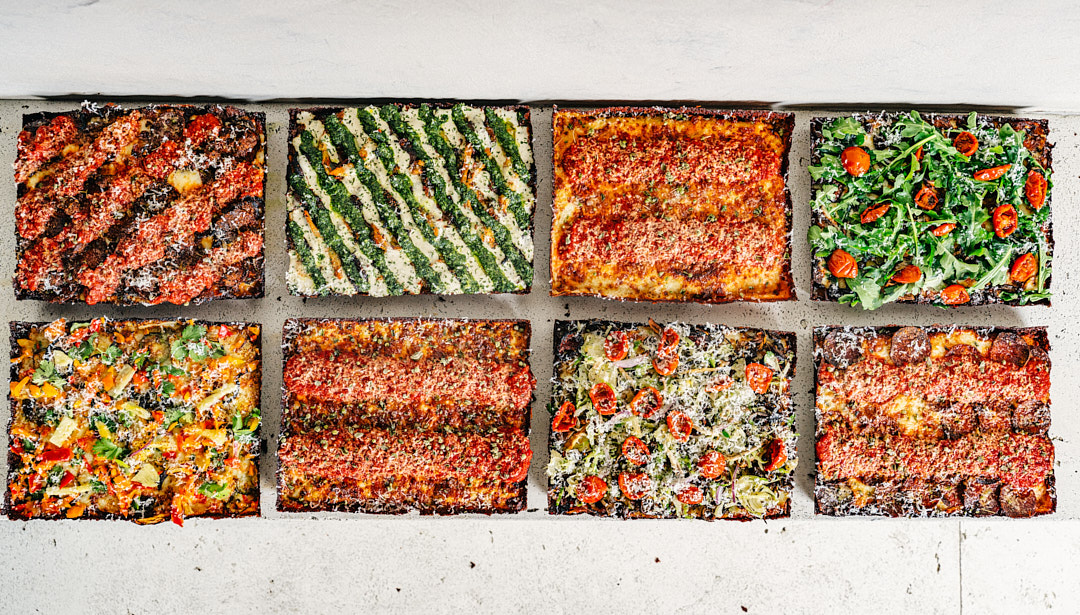CuriosiD: Who made Detroit-style pizza first?
One listener wanted to know the origins of Detroit-style pizza.

WDET’s CuriosiD series answers your questions about everything Detroit. Subscribe to CuriosiD on Apple Podcasts, Spotify, NPR.org or wherever you get your podcasts.
In this episode of CuriosiD, listener Tim Kaiser asks…
“What is Detroit-style pizza?”
The short answer
Detroit-style pizza was invented by Gus Guerra and his family in 1946 at the original Buddy’s Pizza location on Detroit’s east side. The pizza is square and known for its focaccia-like crust, Wisconsin brick cheese and stripes of bright red tomato sauce on top.
How do you make a Detroit-style pizza?
The order of assembly is essential. It’s almost like an upside-down pie. And yet, it’s a relatively simple dish to make.
The dough consists of salt, water and yeast, and is pressed into a rectangular pan to proof, or rest, for a couple hours. The toppings are then placed directly into the dough for optimal flavoring (think pepperoni-saturated focaccia). Detroit-style uses Wisconsin brick cheese, which has a higher fat content than mozzarella. The brick cheese is sprinkled all the way to the pan’s edges and tomato sauce is ladled on top.

When the pizza is ready to bake, it’s placed in an oven at 600 degrees for 13 to 14 minutes.
To be clear, this is the original way to make Detroit-style pizza, not the only way. And when we say original, we mean Buddy’s way.
Buddy’s Pizza — a local legend
Detroit-style pizza was invented in 1946 by Buddy’s Pizza owners Gus and Anna Guerra at the restaurant’s original location on Six Mile and Conant Street. Anna’s family emigrated from Sicily to the United States and brought with it a recipe for a type of Sicilian pizza called sfincione. With its spongy, focaccia crust and toppings baked directly into the dough, sfincione became the inspiration for what is known as Detroit-style pizza today.
“The preparation creates more of a light crunchy crust,” says Wesley Pikula, the chief brand officer of Buddy’s Pizza. “That’s kinda what gave it its original folklore and love, because people would see this thick pizza come to the table and they would bite it and it would be like air.”

Pikula says a key part of Detroit-style pizza is the pan. Buddy’s original pans came from a local auto factory where they were being used as nuts and bolts collectors. To this day, Buddy’s Pizza uses rectangular blue steel pans modeled after the factory dishes.
Once the Guerras found the right pans it was on to baking pizzas and, no surprise, they were a hit. Detroiters from all over town would make the journey to Six Mile and Conant to taste the square pizza.
But the family didn’t stick around for long. In 1953, the Guerras sold Buddy’s along with the original Detroit-style recipe and opened another local legend, Cloverleaf Bar and Restaurant. The square-shaped, thick crusted pizzas these companies produced became a staple in Southeast Michigan and were eventually replicated by places like Shield’s and Loui’s. However, the style wouldn’t make much of a mark outside of the area for decades. That is, not until the 2012 International Pizza Expo in Las Vegas.
Randazzo’s “pizza revolution”
At the 2012 International Pizza Expo in Las Vegas, a crowd cheers as a contestant shakes hands with a panel of judges. The contestant, named Shawn Randazzo, just won the title of “World Champion Pizza Maker of the Year.” And the winning pie? It’s not New York-style. It’s not Chicago-style. It’s not even round. For the first time ever, it’s Detroit-style pizza.
Randazzo grew up in Metro Detroit and delivered for Cloverleaf before becoming a co-owner of one of its locations. After going on to win first place in Vegas, he founded DetroitStylePizza.com. The company offers consulting services and authenticates restaurants with Detroit-style. The website even sells pre-seasoned blue steel pans for businesses and home bakers to use.
Randazzo passed away in 2020 and left behind a successful business empire. Before 2012, Detroit-style pizza was a hyper-local delicacy. By turning his knowledge into a business, Randazzo helped spread awareness of the specialty.
“In the past, the other original pizzerias, Buddy’s and Cloverleaf and all that, they wanted to keep it a secret,” says Linda Michaels, the owner of Detroit Pizza Company and Randazzo’s mother. “But Shawn thought outside of the box, so he went and he started what he called the pizza revolution. And he trained people around the country and around the world.”
Detroit-style gets big
In the last decade, Detroit-style pizza restaurants have popped up all over the country.
“I can’t tell you how many times I get a Google alert, telling me about another Detroit-style pizza place in another state,” says Serena Maria Daniels, the Detroit city editor for Eater and co-founder of Tostada Magazine. “And I think people are starting to really have fun with it. So we’re probably going to see different styles of toppings and flavors and combinations. Really the sky’s the limit when it comes to this stuff.”
A few notable out-of-state Detroit-style pizza spots are Joyride Pizza in San Francisco, Emmy Squared in New York City, and Motown Square Pizza in D.C., which was opened by a Detroiter. These newer restaurants take aspects of the original Buddy’s recipe, like Wisconsin brick cheese and focaccia-like dough, and make it their own.
“We hear people say, ‘I am so glad you’re doing Detroit pizza. I just moved here from Michigan, never imagined that there would be so much and we love it,’” says Joshua Jacobs, co-owner of Joyride Pizza.

He admits that not all Michiganders are immediately sold on the restaurant’s California take on Detroit-style. But he says most are quickly swayed after taking a bite.
“Some people are a little bit surprised like, ‘Brussels sprouts, on your Detroit pizza? I was a little skeptical but I’m a convert.’”
Out-of-state restaurateurs like Joshua and his brother Jesse Jacobs are experimenting with Detroit-style, but they’re not the only ones. Detroit is experiencing its own sort of pan pizza renaissance.
Made in Detroit
Detroit is known for its ingenuity, and that applies to its pizza, too. There’s Grandma Bob’s and Michigan and Trumbull in Corktown that use ingredients like honey and goat cheese. On the west side, there’s The Detroit Pizza Bar with its white sauce seafood pie named for former Detroit Mayor Coleman Young.
“We’ve named some things after namesakes of Detroit,” Akunna Olumba, co-owner of the Detroit Pizza Bar says. “We’ve got the Supremes, which is our all meat pizza. We’ve also got the Temptations and the Ohio Players.”
And, by the way, all three of these local restaurants have vegan options on their menus.
Meet the listener

Museum worker Tim Kaiser grew up in Rochester Hills in the 1970s-1980s and doesn’t remember hearing much about Detroit-style pizza.
“And so I just assumed it was another name for a deep dish, like a Sicilian pizza,” Kaiser says. “And then I had it and oh – it was so good.”
Kaiser is now an avid consumer of the square-shaped delicacy.
We want to hear from you!
For an upcoming episode of CuriosiD, tell us your memories of Boblo Island. Call 313-403-5747 and leave us a voice message or tweet us at @CuriosiDWDET. We might include your comments in a future CuriosiD episode!
Have a general question about Detroit? Ask us here or fill out the form below.
More from CuriosiD:
- What’s the Origin of the Boston Cooler?
- CuriosiD: Who is painting the “Corn Real Good” signs?
- CuriosiD: We Answered All Your Questions About the Mile Road System
Trusted, accurate, up-to-date.
WDET strives to make our journalism accessible to everyone. As a public media institution, we maintain our journalistic integrity through independent support from readers like you. If you value WDET as your source of news, music and conversation, please make a gift today.

